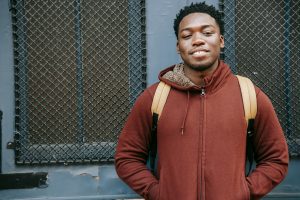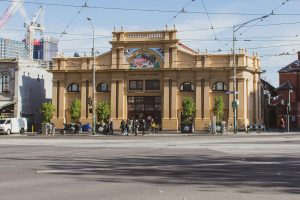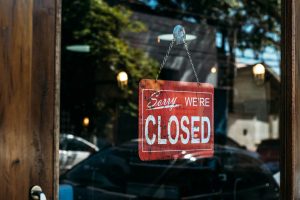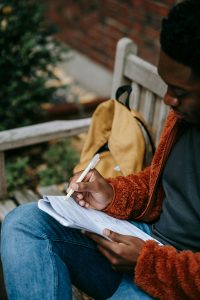11 Jesse Haslop

By Emily Rawlings & Danielle Hitch
Jesse (shortened from Essien) is a 26-year-old man who emigrated to Australia from Ghana with his family as an infant. His mother is Ghanaian and his father is South African. After completing high school, he took a gap year to travel and spend time with his extended family in Ghana. Upon his return to Australia, he worked in the construction industry as a labourer for four years and then completed a Certificate IV in Engineering at TAFE. His success in that course led to him enrolling in a degree in Electrical Engineering, and he is now in his second year of study. He often attends live music concerts and is a dedicated and passionate fan of the Melbourne Victory soccer club.
“I’ll never forget how hard I worked as a labourer … those guys are heroes. Every day at uni is a reminder of how far I’ve come”.
Home Life
Jesse lives with two male flatmates in a large multi-storey apartment complex in the city. He is friends with one of his flatmates but the other flatmate is new and he doesn’t know him as well. Most of his current friends are from his university course, but he also hangs out with people from his TAFE and labouring days. Jesse lost touch with many of his high school friends during his gap year but would like to catch up with them again sometime.
Jesse’s mother and father still live in his childhood home in the outer Western Suburbs, and all his five siblings (three brothers and two sisters) are still living at home. He has a close relationship with his family, phoning them every day and visiting at least once a week. Jesse also has regular contact with extended family in Ghana online but has no other family members living in Australia. His mum has been in remission from breast cancer for the past year but experienced serious side effects from her chemotherapy which have not fully resolved.
Jesse does not have a partner currently, having recently broken up with his long-term girlfriend. He feels some pressure to get into a new relationship, partly due to pressure from his parents and partly because many of his friends are getting married. While he is active on dating apps, he finds speaking to potential partners stressful due to his shy and quiet personality.
“My friends all say I should work on my ‘swagger’, but it’s not me … and there don’t seem to be many quiet or shy girls online.”
Community

Queen Victoria Market. Photo by Maxio Aeson from Pexels.
Jesse lives in Melbourne, which is a major Australia city with a population of 5 million people. The part of the city he lives in is home to many local and international students, and he loves the multicultural character of his local community. There are also many local shops, venues and facilities which cater specifically to students, which are very convenient for socialising after classes. Jesse has generally found the community a friendly place to which he feels a strong sense of belonging. However, he has experienced racist comments and verbal abuse from time to time on the street and in social venues.
“I try not to take it on board – it’s their problem not mine – but it hurts. This is my city as much as theirs”.
Jesse and his flatmates live near a public transport hub and the local market and he spends much of his free time out and about. He enjoys the outdoors and often sits in the city’s parks and gardens to study and relax. Jesse also has a student membership to the university gym and the local swimming baths, and where he exercises 2-3 times per week.
The main downside to living in this community is the cost of living, particularly as a full-time student. Jesse receives a government allowance and picks up casual hospitality work at the uni when he can. He is the first to admit that he struggles with budgeting, and often has to cut back on spending in the days leading up to his next payment. Jesse also worries about his ability to continue paying rent in the apartment due to cost of living pressures.
“Everything is just going up and up and up… there are days when I don’t’ eat just to make it through to the next pay day”.
Health
Jesse has generally experienced good health throughout his life. He had episodes of childhood illness (including chickenpox and hand-foot-mouth disease) but recovered quickly and without complication. Jesse played a lot of sports during his teenage years and recovered quickly from the minor musculoskeletal injuries he had from time to time. He had a bout of glandular fever aged 16 during an outbreak at his school. While the acute symptoms quickly subsided, he experienced significant fatigue for a further 6 months which led to the school allowing him accommodations for his end-of-year exams. However, all his symptoms had resolved by the beginning of the following year.
“Apart from the glandular fever I just don’t get sick. And I’m not a sook that runs to the doctor for every little thing.”
COVID-19
Acute Infection

Jesse managed to avoid COVID-19 for the first two years of the pandemic, which he attributes to the prolonged and strict lockdowns in Melbourne. He was very careful to comply with all public health orders at this time and finds it bewildering that his flatmates and some other friends did not take them more seriously. Jesse was often teased for continuing to wear a mask in public after they were no longer mandatory but felt compelled to protect other people in the community.
“I get it … you want to get back to normal life, but we have to protect people like my Mum.”
However, Jesse contracted COVID-19 in March 2022 as part of the initial Omicron wave. He believes he caught it from his flatmate, and at that point, it was virtually unavoidable because “everyone had it”. Jesse’s symptoms were initially quite mild, with only three days of headache, aching, fatigue, and a runny nose. The only unusual symptom he experienced was an extensive torso rash, which also disappeared after three days. He did not attend the doctor or take any medications, as he felt able to manage his symptoms at home. Jesse was initially relieved to recover quickly as it was the beginning of the uni year and he did not want to get behind in his studies.
Developing Long COVID
However, as time wore on Jesse struggled to return to complete health. He was still feeling significant fatigue and spent much of his free time resting or sleeping in his bedroom. He also continued to have frequent, strong headaches along with dizziness which had never been a problem for him before. Despite his best efforts, Jesse was falling behind in his coursework, and experiencing difficulties with his concentration and memory. The trouble he was having with his studies was noticeable to his tutors, two of whom expressed concern to him about his performance.
“They were trying to help, but it just put more pressure on me. And my Dad just thought I was being lazy”.

His flatmate suggested he go see a doctor, and Jesse made an appointment at the university clinic in July 2022. Upon examination, his blood pressure was 150/90 and his resting heart rate was 120 beats per minute. The doctor explained changes to blood pressure and heart rate were commonly found after COVID-19, but acknowledged it was a bit more unusual after four months. She ordered a range of blood tests and asked Jesse to come back in two weeks with some heart rate and blood pressure readings from his smartphone. However, she said it was probably just done to stress about upcoming examinations or ‘white coat hypertension’ because he so rarely went to the doctor. Given he was fit and young she reassured him it was unlikely to be anything to worry about and would probably correct itself over time.
Jesse did take a couple of readings but more often forgot. He also forgot about the follow-up appointment and couldn’t make another time with that doctor for a further three weeks. This appointment was cancelled by the clinic as the doctor was on unexpected sick leave, and Jesse did not follow up any further at that point. While they were having a significant impact on his health and well-being, Jesse downplayed his ongoing health problems.
“I see these people who have Long COVID in the news and they are properly ill. I’ve really got nothing to complain about – I just need to get on with it”.
While Jesse’s symptoms of Long COVID are relatively mild, they are having a significant combined impact on his daily life. His lingering fatigue is limiting his participation in both study and community activities and is contributing to general deconditioning. Brain fog is affecting his ability to retain new information and stay connected with his friends and previously enjoyed activities. The impact of his symptoms lies in their subtlety; they do not present as obviously as acute COVID-19 symptoms but persistently erode his ability to function.
“I know it’s only a little thing, but I forget to take my wallet with me to the shops … I would never have done that before”.
Current Situation
Jesse feels his energy levels have improved slightly over the past month but are still far below usual for him. He experiences headaches daily, and the painkillers he takes to treat them are causing him constipation. Jesse reports he has episodes of dizziness that come and go and are often accompanied by palpitations. According to his smartwatch, his average resting heartbeat is 110 beats per minute, although it varies over the course of the day between 50 and 160 beats per minute. He has not taken any further blood pressure readings, as he believes that should have fixed itself by now.
Jesse’s grade has declined from an average of 76% to 58% and he is now in danger of failing one of his university units. He is no longer taking on hospitality work, as this depletes his already limited energy levels to the point where he cannot study. As a result, Jesse has been using his credit card to cover energy bills and his rent but is nearing his maximum limit. Apart from university classes and shopping, he rarely leaves the apartment for social activities as they leave him exhausted.
”I’m just hanging in there … just keeping my head above water. I might look OK to everyone, but I’m not”.
Life Roles
Jesse is disappointed and dismayed at his current performance in life roles. All these roles have been disrupted, and some have been lost altogether. His inability to do the activities he previously took for granted leaves him feeling flat and demotivated, and he can’t see how to change things for the better.
“Nothing works … I want to get back to what I was doing before, but the less I do the less I want to do”.
| Role | Before COVID-19 | Currently |
| Worker | Jesse worked casually at the university union bar, between 10 and 16 hours per week. | Jesse has not taken up a shift for the past three months and doubts he will be offered any in the future. |
| Home Maintainer | Jesse shared household tasks with his flatmates and completed them all independently. | Jesse does very few household tasks, and the apartment is often messy. The flatmate he is friends with is very understanding, but this is causing conflict with the other flatmate. |
| Friend | Jesse had a wide social network, maintaining friendships with people from various stages of his life. | Jesse has lost touch with many of his friends outside of his university peers, as he is no longer seeing them socially. He is also seeing his university friends far less frequently. |
| Family Member | Jesse was in daily contact with his family by phone and weekly face-to-face. He also had regular online contact with family online. | Jesse maintains contact with all his family members but is visiting his family face-to-face less often. He has also experienced some conflict with his father, who does not understand why he is doing less with his life now. |
| Informal Organisation Member | Jesse was a member of the university gym and the local swimming baths. | Jesse has let his gym membership lapse but continues to visit the baths irregularly as he finds swimming relaxing. |
| Caregiver | Jesse occasionally helped his mother with household tasks when at the family home. No other caregiving duties. | Jesse no longer helps his mother when at the family home or undertakes any other caregiving duties. |
| Community Member | Jesse socialised in bars and clubs with his friends at least once a week. He also attended most Melbourne Victory matches during the A-League season. | Jesse feels he has withdrawn from the community and is now ‘a bit of a hermit’ in his apartment. |
Activities of Daily Living
Some of Jesse’s activities of daily living have changed a lot since he acquired COVID-19, while he has been able to maintain his participation in others.
“I can do the basics, and I know it’s important that I keep looking after myself.”
Getting the housework done. Photo by Karolina Grabowska from Pexels / Back out and about. Photo by Keira Burton from Pexels. / Dating. Photo by Keira Burton from Pexels.
| Activity | Before COVID-19 | Currently |
| Showering / Bathing | Independent. The apartment only has a shower cubicle. | Independent, but keeps bathing short as he is concerned about getting dizzy in the shower. |
| Toileting | Independent. | Independent. |
| Walking / Moving Around | Independent. Able to walk any distance required at a steady pace. | Independent. Able to walk any distance required at a steady pace, however, begins to fatigue after about 10 minutes. |
| Dressing | Independent. | Independent. |
| Driving / Public Transport | Independent using public transport. Does not have a car. | Independently, but somewhat limited by available energy levels and other symptoms. |
| Safety / Emergency Management | Independent. | Independent. |
| Meal Preparation | Independent, and shared this activity with flatmates. | Independent, but relies on flatmates to make fresh meals cooked from recipes. Provides flatmates with ready meals when it is his turn to ‘cook’. |
| Shopping | Independent, and shared this activity with flatmates. | Independent, but has transitioned to online shopping and delivery only. Jesse has not visited the market for the past three months. |
| Money Management | Independent and able to manage within a tight budget. | Independent for bill paying, but unable to budget sustainably on a reduced income. |
| Community Participation | Independent and able to access all local facilities. | Independent and able to access all local facilities. Limited by available energy levels and other symptoms. |
| Rest / Sleep | Independent. Jesse regularly attained 8 hours of restful sleep per night. | Independent, however, Jesse often experiences broken or shortened sleep (approximately 6 hours per night). He naps in the late afternoon 2-3 days per week but these rests don’t have an appreciable impact on his fatigue. |
| Caring for others | Independent. | Independent, but not currently required to do these activities. |
| Play / Leisure | Independently participated in physical recreation (gym and swimming), social activities and regularly attended Melbourne Victory matches. | Occasionally goes to a local pub with university friends after classes but is no longer visiting venues at night. Jesse has not attended any Victory matches so far this season. |
Jesse’s Goals
Jesse wants to urgently improve his performance at university and return to casual work to improve his financial situation. He would like help with the following goals (but is yet to prioritise them):
- Get rid of the brain fog so his grades can improve.
- Return to his previous casual job or get a new job and start earning more money.
- Going out more often with friends, attending more social events, and getting back to visiting his family once a week.
- Doing his fair share of the housework in the apartment.
- Find a new partner.
“I should be in the prime of my life … this isn’t what I had in mind.”
What does the evidence say?
The risk factors related to contracting COVID-19 and developing Long COVID are complex.
- While older people have a higher risk of poor outcomes from COVID-19 infection[1], younger people may be more likely to contract the virus due to their generally more sociable lifestyles, especially following the relaxation of public health measures[2]
- People from Culturally and Linguistically Diverse communities experienced health inequality even before the pandemic, and are frequently marginalised from research and public health initiatives[3]. Along with the impact of racism and other systematic inequalities, these factors can contribute to the higher risks of both COVID-19 and Long COVID experiences by people from CALD communities[Shabnam, S., Razieh, C., Dambha‐Miller, H., Yates, T., Gillies, C., Chudasama, Y.V., Pareek, M., Banerjee, A., Kawachi, I., Lacey, B., Morris, E., White, M., Zaccardi, F., Khunti, K., & Islam, N. (2022). Socioeconomic inequalities of Long COVID: findings from a population-based survey in the United Kingdom. medRxiv.]
Persistent cardiac and dysautonomia are frequently reported by young adults following COVID-19 infection.
- In the months following COVID-19, around a quarter of people are diagnosed with a new cardiac condition[4], most commonly hypertension (20%), tachycardia (24%) and Postural Orthostatic Tachycardia Syndrome or POTS (13%). All of these conditions can have a serious impact on longer-term health, and require monitoring and/or active treatment.
- However, young men (particularly those from CALD communities) are much less likely to visit their general practitioner or engage in regular health monitoring[5], putting them at much higher risk of the progression of undetected problems and late presentation for care.
Persistent headaches arising from Long COVID have a significant impact on health, well-being and quality of life.
- Chronic headache is the most common neurological symptom of Long COVID, and is thought to arise from persistent inflammation and abnormal metabolism of neurotransmitters[6].
- Persistent headaches have a significant, but often under-recognised impact on quality of life and function. These symptoms can directly impact quality of life and also exert an indirect impact through the development of depression and its impact on engagement in daily life[7]. For example, the loss of workplace productivity attributed to headaches is greater than that caused by absenteeism[8].
- The secondary issue of constipation Jess is experiencing from his painkiller use will also have a compounding negative impact on his health, well-being and quality of life. However, the provision of education about this condition and its management has been found to decrease symptom severity and increase quality of life[9].
- Pijls, B.G., Jolani, S., Atherley, A.E., Derckx, R.T., Dijkstra, J.I., Franssen, G.H., Hendriks, S., Richters, A., Venemans-Jellema, A., Zalpuri, S., & Zeegers, M.P. (2021). Demographic risk factors for COVID-19 infection, severity, ICU admission and death: a meta-analysis of 59 studies. BMJ Open, 11. ↵
- Australian Government. (2023). COVID-19 Australia: Epidemiology Report 79. Communicable Disease Intelligence, 47, https://doi.or/10.33321/cdi.2023.47.72. ↵
- Gibbs, L., Thomas, A.J., Coelho, A., al-Qassas, A., Block, K., Meagher, N., Eisa, L., FLETCHER-LARTEY, S.M., Ke, T., Kerr, P., Kwong, E.J., MacDougall, C., Malith, D., Marinkovic Chavez, K., Osborne, D., Price, D.J., Shearer, F.M., Stoové, M., Young, K.R., Zhang, Y., Gibney, K.B., & Hellard, M. (2023). Inclusion of Cultural and Linguistic Diversity in COVID-19 Public Health Research: Research Design Adaptations to Seek Different Perspectives in Victoria, Australia. International Journal of Environmental Research and Public Health, 20. ↵
- Ogungbe, O., Gilotra, N.A., Davidson, P.M., Farley, J.E., Dennison Himmelfarb, C.R., Post, W.S., & Commodore‐Mensah, Y. (2022). Cardiac postacute sequelae symptoms of SARS-CoV-2 in community-dwelling adults: cross-sectional study. Open Heart, 9 ↵
- Leone, J., Rovito, M., & Gray, K. (2021). Practical strategies for improving men's health: Maximising the patient-provider encounter. International Journal of Men's Social and Community Health, 4(1), e1-e16. ↵
- Foo, S., Chen, W., Jung, K., Azamor, T., Choi, U.Y., Zhang, P., Comhair, S.A., Erzurum, S.C., Jehi, L.E., & Jung, J.U. (2023). Immunometabolic rewiring in long COVID patients with chronic headache. bioRxiv. ↵
- Kim, S., & Park, S. (2014). The role of headache chronicity among predictors contributing to quality of life in patients with migraine: a hospital-based study. The Journal of Headache and Pain, 15, 68 - 68. ↵
- Simic, S., Rabi-Žikić, T., Villar, J.R., Calvo-Rolle, J.L., Simić, D., & Simic, S.D. (2020). Impact of Individual Headache Types on the Work and Work Efficiency of Headache Sufferers. International Journal of Environmental Research and Public Health, 17. ↵
- Ozturk, M.H., & Kılıc, S.P. (2019). Effective of education on quality of life and constipation severity in patients with primary constipation. Patient education and counseling, 102 2, 316-323 . ↵

